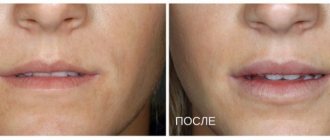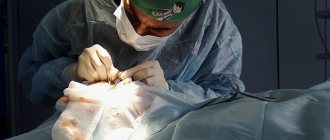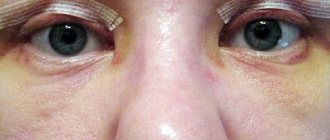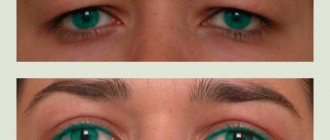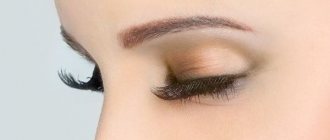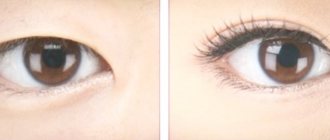Blepharoplasty is a plastic surgery that allows you to correct the shape of the eyes, remove drooping eyelids and bags under the eyes. Many women resort to such surgical intervention; the procedure is quite simple, easily tolerated, but requires effective pain relief. Anesthesia for blepharoplasty can be general or local; what type of anesthesia will be used depends not only on the patient’s personal preferences, but also on the volume of the operation, associated disorders, tolerance of painkillers and a number of other conditions.
Types of anesthesia used for blepharoplasty
Blepharoplasty involves removing fat deposits and tightening muscles through incisions in the skin. Naturally, such manipulation is accompanied by severe pain, so it is impossible without high-quality pain relief. Blepharoplasty can be performed under local or general anesthesia:
- Local anesthesia is local anesthesia of the skin and subcutaneous fat in the affected area. That is, the introduction of a local anesthetic temporarily disables pain receptors specifically in the eye area, and allows operations to be performed without general anesthesia;
- General anesthesia. This term refers to the intravenous or inhalational administration of anesthetics, leading to inhibition of the central nervous system, as a result of which pain sensitivity disappears, muscles relax, reflex reactions are suppressed and consciousness is turned off. The use of modern drugs allows you to select a dose that has minimal negative effects on the body and its effect lasts exactly as long as necessary for the operation.
Preparation
Young woman having a consultation about blepharoplasty
Preparation for eyelid surgery depends on the type of anesthesia. Before using local anesthetics, preparation is minimal and does not require much effort. It is necessary to stop drinking alcohol 24 hours before the procedure, and you should also refrain from smoking. You should tell your surgeon if you are taking other medications, especially those that make your blood difficult to clot. If the operating doctor has prescribed you to take additional sedatives, you must follow the instructions.
General anesthesia requires more careful preparation. It is very important to quit smoking two months before the scheduled date of aesthetic surgery - blepharoplasty. Smoking greatly affects the lungs and after medicated sleep it can even provoke pneumonia. It is also not recommended to consume alcoholic beverages during the day before surgery, and then avoid it for the entire recovery period.
What problems does blepharoplasty solve?
Eyelid surgery in most cases is the correction of various age-related changes: hernias of the lower eyelids (commonly called bags under the eyes), sagging skin, wrinkles. Depending on the indications, plastic surgery of the lower, upper or both eyelids is performed. In more rare cases, blepharoplasty is used to correct birth defects and change the shape and size of the eyes.
Where do bags under the eyes come from?
With age, some people's soft tissues (skin, orbicularis oculi muscles) lose their elasticity. Subcutaneous fat accumulates, resulting in the formation of hernias or so-called bags under the eyes. The formation of hernias is influenced by genetic predisposition and lifestyle - poor nutrition, lack of sleep, overwork, stress, alcoholism. Some women face this problem after giving birth. Sometimes, due to anatomical and genetic predisposition, hernias occur in adolescence at 15-16 years old and can be corrected then.
What types of eyelid surgery are there?
There are two main types: classical and transconjunctival. The classic version is performed on the lower and upper eyelids: the hernia and overhanging skin of the upper eyelid are removed. Transconjunctival blepharoplasty only relieves hernias. It is usually done at the age of 30-35, when there is no sagging skin yet. After such an operation there are no scars left, because the incision is made under the skin, on the mucous membrane of the lower eyelid. It is done with a scalpel or laser. Operations in both cases give the same results. The laser makes the operation less traumatic, as it immediately seals the vessels, the bleeding stops, and bruises do not form.
The type of blepharoplasty is chosen according to the indications: if you need to have plastic surgery of the upper and lower eyelids due to a hernia and excess skin, then it is recommended to do a classic operation. Yes, after a classic operation, white stripes remain on the eyelid, but it is not possible to remove excess skin in any other way.
Is it possible to get rid of hernias without surgery? For example, adjust your diet and rest regime?
A hernia, if it has formed, will not go away on its own. If a person leads a healthy lifestyle, gets enough sleep and eats right, but has bags under his eyes, this is an aesthetic problem that requires a surgical solution. But many live with bags under their eyes and are successful in all respects.
What still makes you go for plastic surgery?
Patients say that this cosmetic flaw really prevents them from feeling confident at work and at home. They are irritated by bags, drooping eyelids, and feel physically uncomfortable. Moreover, men undergo blepharoplasty not much less often than women. But the men hide the fact that they went through the operation. And women are increasingly no longer ashamed of aesthetic operations and openly talk about them.
Are there any contraindications?
Contraindications may include severe cardiovascular diseases, diabetes mellitus, blood diseases, progressive myopia, oncology and other diseases that pose an immediate threat to life.
Does blepharoplasty require special preparation?
They prepare for it in the same way as for any other operation. The preparatory complex depends on the method of anesthesia: local or general. Before surgery with local anesthesia, it is enough to undergo standard examinations: blood tests for biochemistry, general for infections and a coagulogram (clotting)
. You may need to consult a therapist or specialist who is seeing you for some chronic disease. For example, see a cardiologist for heart problems. If the operation is planned under general anesthesia, an ECG, fluorography or chest x-ray and consultation with an anesthesiologist will be needed.
What determines the choice between general and local anesthesia?
How difficult is blepharoplasty?
It has been done for a long time and is well proven; it does not pose a danger to life and health. But any wound can fester, become inflamed, and the stitches can come apart. Most often we are talking about aesthetic complications. Jeweller's precision is needed, then scars will not be noticeable and the patient will be satisfied. But various asymmetries occur, including inversion of the lower eyelid. This occurs due to the cutting of an excessive amount of soft tissue of the skin, then the cartilage of the lower eyelid cannot stand it and pulls down. Ophthalmological complications are also possible. The mucous membrane is indirectly affected, sometimes conjunctivitis, keratitis, lacrimation, and dry eyes develop. But these are rather exceptions to the rule and are quite rare.
Is it possible to correct the consequences of an unsuccessful operation?
Any unsuccessful scar can be corrected, but only after six months. If the postoperative suture is torn, it must be sewn up immediately. It will look unaesthetic, but you will have to be patient. After six months, you can make a correction.
How quickly does the patient leave the hospital and return to normal life?
If the operation was performed under anesthesia, the patient remains in the hospital overnight and goes home the next day. You can leave after surgery with local anesthesia within a few hours.
As a rule, sutures are removed on the 4-5th day. They usually return to work after two to three weeks, when the swelling goes away. Some go to work the day after surgery. It depends on whether the patient wants to hide the operation or not. After 2-3 months, no traces remain. All scars completely disappear.
Are there any peculiarities of recovery after eyelid surgery?
The skin of the eyelids is very delicate; after plastic surgery, bruising and swelling appear. On the 4-5th day the swelling goes away, but the bruise remains for 10-14 days. The average recovery time is 2-3 weeks. For some it heals faster, for others it heals more slowly. No special medications are prescribed after surgery. At the patient's request, physiotherapy is performed to speed up healing. Before the stitches are removed, you cannot wash your face because of the special bandages on your eyelids. For two weeks after surgery, you must remain calm and avoid lifting heavy objects. You can resume sports activities after a month.
Does eyelid surgery solve the problem for life or does it need to be repeated periodically?
It all depends on your lifestyle. As a rule, this operation is repeated after 10-15-20 years.
Choose!
Experts often have different opinions. Where one recommends blepharoplasty, another recommends a forehead lift and lipolifting, a third recommends thread lifting, a fourth recommends correction with endotins, and a fifth thinks that deep peeling will help you. At the same time, everyone will convincingly prove that they are right, citing many reasonable arguments. Whose recommendation to choose is up to you.
Personal experience
Tatyana, 49 years old, veterinarian
I had lower eyelid hernias. I felt uncomfortable because of this. At first I wanted to remove only the hernia of the lower eyelids, but then I decided to tighten the upper eyelid and completely put my eyes in order. I had surgery about 4 years ago.
The operation took place under local anesthesia. It is quite painful and generally an eerie feeling. The most difficult test is being injected with painkillers before surgery and pulling out hernias. Then the excess skin is cut off and stitched. The operation lasts 30-40 minutes. Then I lay with ice for about an hour or two. Anesthesia before the eyes and after the operation is felt quite strongly: the eyes see double or triple. I walked staggering, as if I was carrying a vessel of water and was afraid of spilling it. I went home the same day.
Before the stitches were removed, I slept for 3 days, half-sitting; sleeping as usual (especially on my side), bending over, making sudden movements, and lifting anything heavy during this period is prohibited. If blood rushes to the eyelids, a hematoma may form. After 3 days, the stitches were removed. I had no bruises or hematomas, only a slight yellowing, and, of course, fresh scars stood out under my eyelashes. After 2 weeks I went back to work. Almost nothing was noticeable. The only thing is that the shape of the eyes changed after the operation, became more rounded, and thin seams under the eyelashes still remain.
Maxim Osin:
I recommend performing upper and lower eyelid surgery under general anesthesia.
And local anesthesia is used when it comes to surgery of only one eyelid; when correcting both eyelids at once, surgery under local anesthesia is difficult to tolerate. White stripes-scars on the eyelids really remain forever. Nina, 46 years old, manager
In the first days after the operation, I went on business, left the house, went to the car, it seemed to me that it was faulty. I leaned over to check if everything was okay. The blood rushed to the face and a hematoma formed on the eyelid. I had to cut it again and clean it out. This still left a stain. As a result, I had this operation again, but with a different doctor.
Maxim Osin:
When bending over, a bruise sometimes forms, and the stitches can come apart.
Therefore, it is recommended to avoid such situations: do not bend over too much so that the blood does not rush to your face, do not understand heavy weights, etc. But this is not a rule, but rather a matter of chance. For some this happens, others behave as usual after the operation and no problems arise. Of course, it's better not to take risks. Anastasia, 38 years old, housewife
Six days ago I had blepharoplasty of the upper and lower eyelids (transconjunctival). I look at myself in the mirror and it seems that my eyes are completely different now. One eye looks more open than the other, and the stitching on it seems to be pulling. And it feels like the seam on one eye is lower than on the other. The operation was performed by a good surgeon, according to reviews from his patients. And I myself can’t believe that a surgeon could allow such a defect in his work. Relatives console me, they say that I am finding fault with myself, others cannot see my contrived shortcomings.
Maxim Osin:
A week after the operation it is impossible to evaluate the result.
It will be visible only a month later. In this case, the defect may be caused by swelling and will disappear over time. Victoria, 42 years old, accountant
I had upper blepharoplasty 3 months ago. One eye was more open than the other, and there was excess skin hanging over one eye. It seemed to me that the doctor removed too little. I thought that I would have to operate on this eye again, but then gradually everything fell into place. Now everything is fine, although the seams are at different levels. On one eye the seam is completely invisible, on the other - if you know about it. As I was told, the seams may be slightly asymmetrical, since the eyes and folds of the upper eyelid do not have symmetry.
Maxim Osin:
Indeed, if there is asymmetry before surgery, it persists after it.
Alla, 45 years old, lawyer
I chose my surgeon quite carefully. The doctor needs to instill confidence. During the consultation, the doctor truthfully explained that he would not be able to perform transconjunctival blepharoplasty on me. I'm over 40, so I need to do classic blepharoplasty. It will leave behind excess skin, which you will have to deal with later. But he promised to remove the bags under my eyes and showed me how beautiful I would be after the operation. She was operated under general anesthesia. A week after the operation, the stitches on the upper eyelids were more noticeable than on the lower ones. One eye was watering, I couldn’t see well—there was a feeling of a foreign body, so I used special drops. A week later, there was almost no scar under this eye, under the other it was barely noticeable, but a bag remained, as if there was no operation. It resolved only after 5 months.
Maxim Osin:
The patient’s age is important. If a person is over 40 years old and has drooping eyelids and wrinkles, then transblepharoplasty will not be able to solve all the problems - one must choose the classic option.
The bags and swelling disappear completely after a month, but sometimes they can remain for a longer time. Everything here is very individual. Anna, 42 years old, manager
Just a couple of months ago, I took bags under my eyes for granted. I went to a cosmetologist to get a Botox injection. The cosmetologist said that hernias under the eyes can be removed and advised a doctor. I read reviews on the Internet and came across the concept of “transconjunctival blepharoplasty”. I went for a consultation, where a surprise awaited me: it was too late for me to do this type of plastic surgery, only the classics. On the 3rd day after the operation, the swelling had almost subsided, leaving only yellow bruises under the eyes. Everything looked pretty decent, only there was a clear wrinkle under the right eye, but it was there before the operation.
Maxim Osin:
Transconjunctival blepharoplasty can only get rid of hernias.
It is done at the age of 30-35, when there is no such problem as sagging skin. Later, more radical solutions are needed, so classic blepharoplasty is done, it removes wrinkles. Especially for men
Mikhail, 37 years old, manager
Two weeks ago I had lower eyelid surgery. There were no indications to operate on the upper .
There are no longer any traces left, except for barely noticeable scars in the corners of the eyes. I think they will disappear in a couple of weeks. Everything took place under local anesthesia. There is an unpleasant feeling from the first injection, as during dental treatment, and then when the hernia is pulled out. I can't say it hurts, but rather unpleasant. In general, everything is painless: both the operation itself and after it there is no pain. I even regretted that I did not come in my own car.
Maxim Osin:
Indeed, if the upper eyelid does not droop, then you can limit yourself to plastic surgery of the lower one.
This operation is quite easy under local anesthesia. Blepharoplasty is the correction of the upper and lower eyelids. During plastic surgery, bags under the eyes and drooping eyelids are removed.
Surgery is performed both under local anesthesia and with the help of medicated sleep.
Anesthesiologists argue that performing surgery under local anesthesia is more appropriate than using medicated sleep, but only if surgery is performed on one of the eyelids - upper or lower.
In addition, the choice of type of anesthesia will be influenced by the complexity of the operation.
What to choose - general or local anesthesia
What anesthesia is required for blepharoplasty? It is better to choose the type of anesthesia together with your doctor. Most patients prefer local anesthesia, but you need to know that such anesthesia is only possible if the correction concerns only the lower or upper eyelid. With such an intervention, the volume of the operation is insignificant and not particularly complex in terms of technique, so local anesthesia will allow the plastic surgery to be carried out efficiently.
Most doctors even prefer to combine local anesthesia with sedation, since this puts the patient into a shallow sleep, therefore relaxes and does not interfere with the doctor’s eyelid surgery.
General anesthesia is definitely used if circular blepharoplasty is necessary - simultaneous correction of the lower and upper eyelids, changing the shape of the eyes. Such an intervention requires more time and full concentration of the surgeon, and the effect of local anesthesia to comply with these conditions is insufficient. When choosing an anesthesia option for blepharoplasty, not only the type of correction is taken into account, but also a number of other conditions:
- Patient's age;
- Psycho-emotional status. For people with a high level of anxiety, neuroses, suspiciousness and doubts, general anesthesia is recommended, since with local anesthesia there is a high probability that they will constantly distract the surgeon, which will not have the best effect on the quality of blepharoplasty;
- Tolerance of local anesthetics. A number of patients are allergic to drugs from this group, so they are indicated for general anesthesia;
- Diagnostic data. Before blepharoplasty, an extensive examination is required; it is also necessary to identify indications and contraindications for anesthesia.
Any anesthesia requires preparation of the patient, so the type of anesthesia is selected in advance.
What is blepharoplasty
This operation is performed not only for aesthetic, but also for medical reasons. For example, blepharoplasty (translated from ancient Greek blefaros
- “eyelid”) is done to people suffering from entropion - outward turning of the eyelids. With this pathology, the eyes are constantly irritated, watery and inflamed, so surgery is simply necessary for normal vision and lifestyle.
But still, most patients undergo blepharoplasty at their own request to make their face more attractive. Indeed, such an operation can solve a number of aesthetic problems:
- get rid of sagging eyelids and “tired eyes”;
- change the shape of the eyes by removing the “Mongolian fold”;
- reduce signs of age-related changes;
- eliminate eyelid defects (sagging, excess skin, bags under the eyes).
Depending on the complexity and duration of the operation, as well as on the wishes of the patient, general or local anesthesia is given before blepharoplasty.
Preparatory stage
Preparing a patient for blepharoplasty involves conducting a number of examinations, these are:
- Blood test, including blood clotting, sugar, infections;
- Fluorography;
- ECG – electrocardiogram of the heart.
Consultation with an ophthalmologist and anesthesiologist is required. If general anesthesia is necessary, permission from a physician or cardiologist will be required. For the operation itself to be successful and for no negative consequences to arise, the following is required:
- At least 3 weeks before surgery, stop smoking, drinking alcohol and using blood thinners;
- Compliance with diet therapy on the eve of blepharoplasty. The day before surgery, preference should be given to easily digestible foods; in the morning before surgery, you should not eat or drink.
The patient should be warned in advance about the type of anesthesia chosen, the characteristics of its effect on the body and the condition after the operation.
Planning the operation
If everything is fine with the tests, then preparations for blepharoplasty take place. The surgeon evaluates the patient’s appearance, analyzes the shape of the eyes and eyebrows, the condition of the muscles, the amount of excess skin and fatty tissue, identifies the severity of facial wrinkles and tells the patient what results can be obtained using a particular blepharoplasty technique.
He should talk about all the methods, their advantages and disadvantages. But, taking into account the patient’s age, his wishes, the condition of the tissues, individual structural features, and budget, the surgeon must recommend the most suitable method. After this, he explains how the operation and rehabilitation period will proceed, and what complications may arise.
It is imperative to clarify all financial issues before surgery, so that there are no questions or disagreements later. To track all changes in appearance, the surgeon takes photographs of the patient from different angles. Many clinics offer computer modeling. Thus, you can see your appearance as close as possible to the result of the operation.
We recommend: Is it possible to do blepharoplasty after Botox?
Features of local anesthesia for blepharoplasty
Pain sensitivity during local anesthesia is turned off in two ways:
- Application - cream is applied to the desired area of the body or gel with anesthetics is sprayed;
- Injection - the anesthetic is injected under the skin using a syringe with a needle.
Blepharoplasty under local anesthesia is performed after injection of drugs. The application method is not used for this type of plastic surgery, since external agents do not penetrate deeply and therefore do not affect the subcutaneous fat. In most cases, injection anesthesia is performed with drugs containing ultracaine, lidocaine, and buvicaine.
How is the operation performed?
Whether local or general anesthesia is ultimately used, the patient follows the same rules regarding the preoperative period. So, you should not take blood-thinning medications, and stop drinking alcohol and smoking 2 weeks before the intervention. The patient submits a list of tests, and doctors also compile his allergy and anesthesiological history so that during the operation there are no complications or threats to the patient’s health and life.
Before the operation, the plastic surgeon applies special markings on those areas of the eyelids where eyelid surgery will be performed. Then an antiseptic is applied to the entire face and painkiller injections are administered. After the anesthetic takes effect, the plastic surgeon begins manipulations.
After the operation is completed, the patient spends several hours in the ward under observation. If no complications arise, painkillers (tablets or injections) are prescribed, then the patient is discharged home.
Is it painful to have blepharoplasty under local anesthesia?
To ensure that the patient does not feel pain and is not under anesthesia, two methods are used.
- The first is called application, which involves local application of an anesthetic cream or spray. After this, the area becomes numb, but the cream does not affect the deeper layers. This method of pain relief is usually used for Botox or filler injections.
- The second method is injection. From the name it is clear that the anesthetic drug is injected into the tissues using an injection, which allows the active substance to penetrate the subcutaneous fat and muscles. Typically the drug contains lidocaine, ultracaine and bupivacaine.
The injections themselves are quite unpleasant to endure, because the injections are administered to a considerable depth, and the periorbital area itself is very sensitive. When the operation itself takes place, there will be no pain, but all manipulations will be felt - the pressure of the instruments, the moving threads during suturing. The process will resemble dental treatment with anesthesia, when the movements of dental instruments in the oral cavity are felt, but without pain.
During blepharoplasty, the patient will see the light of surgical lamps, and also, if a laser is used instead of a scalpel, the person lying on the operating table will also have to inhale the smell of burnt meat. Not everyone can cope with such an ordeal calmly, so sedatives are often added to local anesthesia to put the patient into a calmer, sleepier state.
If the patient has a low pain threshold or is too sensitive, then intravenous sedation is usually recommended. Consciousness is switched off, which makes this option of pain relief almost equivalent to anesthesia, with which they differ only in the dosage of drugs and the possibility of spontaneous breathing.
How long the pain relief will be provided depends on the amount and concentration of the drug administered. The individual characteristics of the patient’s body also have an impact. There have been cases when during surgery the patient feels that the effect of the painkiller is decreasing. In such a situation, you need to tell the plastic surgeon about this, who will administer an additional injection.
Advantages and disadvantages
Blepharoplasty under local anesthesia is preferable to general anesthesia. The main advantages of such pain relief are:
- Slight risk of developing systemic severe complications, possible due to the toxic effects of drugs used during general anesthesia;
- Ability to follow physician orders. During the operation, the surgeon may ask the patient to periodically close and open his eyes, which has a positive effect on the results of the correction;
- Short rehabilitation period after anesthesia. The patient can be under the supervision of clinic staff for only 2-3 hours, and then he is sent home.
Despite the obvious advantages of local anesthesia for blepharoplasty, this type of anesthesia is not always used. Its disadvantages are:
- Possible increase in blood pressure. During plastic surgery on the eyes, most patients are nervous, which often leads to increased blood pressure. This condition does not threaten health, but increases the risk of bleeding, which complicates the surgeon’s work;
- Risk of allergic reactions to the anesthetic used;
- Inability to use local anesthesia for extensive surgery. Most often, local anesthesia is prescribed for upper eyelid blepharoplasty. When correcting a defect in the lower part, the incision is made from the inside and this is not always possible if the operated person is conscious.
General anesthesia
For large volumes of work, blepharoplasty is performed under general anesthesia. Typically, these are operations for older patients who need a circular eyelid lift. This takes from 2 to 3 hours, so local anesthesia will not be suitable for at least two reasons. Firstly, anesthetics have a short-term effect, and it would be necessary to constantly add injections. Secondly, it is difficult for the patient to endure prolonged lying in one position.
By the way! The patient can be given general anesthesia at his personal request, even if it is a simple intervention. Some people are terrified of operations and want to see and feel absolutely nothing during them.
A person must inform in advance about his desire to have blepharoplasty under general anesthesia so that the doctor can prescribe additional examinations if necessary. This may be blood biochemistry, as well as echocardiography.
Technique
General anesthesia can be intravenous or inhalational, and for blepharoplasty the first option is used. Inhalation is not suitable due to the need to constantly keep a mask on the patient’s face, which will interfere with manipulations. Therefore, liquid anesthetics are selected that can be administered through a vein. These can be different combinations:
- morphine and trimeperidine;
- droperidol and fentanyl;
- promedol, fentanyl, ketamine;
- diazepam, phenazepam, atropine.
While still in the ward, the patient is given premedication - light sedatives are administered to prepare the body for general anesthesia. He then comes into the operating room and lies down on the table. It is connected to all devices; a pressure measuring device is put on one arm, and a catheter is inserted into a vein in the other arm to administer an anesthetic for general anesthesia and other medications if necessary. The person slowly “passes out” and the doctor begins the operation.
After operation
Blepharoplasty itself is considered a simple intervention, but due to general anesthesia, the patient must remain under medical supervision for another day. It is difficult for a person to recover from medicated sleep: dizziness, nausea, and confusion are possible. You may also experience pain in your back and muscles due to lying in one position for a long time. Medical staff are nearby, ready to calm the patient and help him go to the toilet. You cannot eat or drink for some time (3-4 hours).
After blepharoplasty under general anesthesia, the patient goes home a day later or when the doctor considers his condition stable.
Blepharoplasty under general anesthesia
General anesthesia can be intravenous or inhalational. When performing blepharoplasty, preference is increasingly given to TIVA anesthesia - a modern method of turning off consciousness. The abbreviation TIVA stands for total intravenous anesthesia, which uses only a mixture of drugs injected into a vein. Inhaled drugs to inhibit central nervous system are not used with this type of anesthesia. The main advantages of TIVA anesthesia:
- There is a slight likelihood of nausea and vomiting after anesthesia;
- Hemodynamic stability of the patient;
- Lowest risk of toxicity for the patient;
- Reduced pressure inside blood vessels;
- Fast recovery period after surgery.
TIVA anesthesia provides automatic administration of a pre-calculated dose of anesthetics and continuous monitoring of the patient's condition. Total intravenous anesthesia can also be used if the patient has a persistent form of arterial hypertension.
General anesthesia, unlike local anesthesia, ensures complete relaxation of the muscles and switches off the patient’s consciousness, which allows the doctor not to be distracted during blepharoplasty by factors unrelated to the course of the intervention. After general anesthesia, the likelihood of systemic adverse reactions is high. But their development depends mainly on how correctly the dose of the drug is selected. When calculating it, the patient’s weight, age, and the presence of concomitant diseases are taken into account. Therefore, only a qualified anesthesiologist can give high-quality anesthesia.
Possible complications after blepharoplasty
The most dangerous complication of local anesthesia is an allergic reaction to the components of the drug, which can lead to anaphylactic shock. To avoid this, the surgeon and anesthesiologist examine the patient's health status and, if there is reasonable doubt, perform a sensitivity test. This test is also performed at the request of the patient. But even if the test turns out to be positive, then with the wide variety of modern anesthetics available today, it will not be difficult for doctors to replace the substance in the drug that causes an allergy in the patient.
Side effects of local anesthesia may include puncture of the vessel, which will cause the patient to feel a burning sensation during the injection. After surgery, puncture of the vessel may lead to the formation of a bruise. There is also a risk of impaired spontaneous breathing, but this complication occurs in patients with a history of serious respiratory dysfunction. But for such patients, local anesthetics are generally contraindicated.
Reviews of circular blepharoplasty under general and local anesthesia
Olga, 50 years old “I had blepharoplasty performed under general anesthesia with sedation. My consciousness was foggy, that is, I perceived the staff’s conversations and their actions as if from the outside. There was no pain or discomfort, and the procedure itself went quickly for me. After the end of the operation I felt lethargic for some time and had slight dizziness, then everything returned to normal. I am quite satisfied with the effect of blepharoplasty, as well as the pain relief; after a few days I no longer felt any negative reactions from the plastic surgery.” Marina, 44 years old “5 years ago I decided to have blepharoplasty. The question immediately arose: under what anesthesia should the operation be performed? A friend recommended local anesthesia. And what I want to tell you is that it was no more painful than at the dentist, and the consequences of general anesthesia were avoided.”
Rehabilitation period
Upon completion of the surgical intervention, a special bandage is applied. It has a cooling effect, which helps prevent bruising and swelling. On the first day after surgery, the patient must remain in the hospital under the supervision of a doctor, but can go home the very next day.
The first few days after blepharoplasty, you need to avoid contact with water, as well as high stress on the eyes: reading, working at the computer, watching TV. To restore skin tone during recovery after blepharoplasty, you need to do eye exercises. The exercises should be simple:
- rotation of eyeballs;
- light pressure on the eyeballs through closed eyelids;
- moving the gaze up and down.
During the first 3 days, you need to use antiseptic drops. On the 5th day of recovery, you need to go to a second appointment with the doctor, where he will remove the stitches. It does not matter whether you are recovering from an upper eyelid lift or a lower eyelid lift, you must follow all recommendations.
If the recovery process is successful, the stitches after the operation become barely noticeable after 3 weeks from the date of surgery. The final result is assessed after 1.5 months. During this time, the swelling goes away, and the incision area is completely healed.
To make postoperative scars less visible, you need to use Contractubex after surgery. This is a special cream that has a resolving effect and smoothes out stubborn tissue.
YouTube responded with an error: The request cannot be completed because you have exceeded your quota.
Rate this article:
- Related Posts
- What is lower eyelid blepharoplasty?
- How is forehead blepharoplasty performed?
- What anesthesia is used for blepharoplasty?
- What is the age limit for blepharoplasty?
- What are the pros and cons of blepharoplasty?
- On what day are stitches removed after blepharoplasty?
Preparation
Before using local anesthetics, preparation for surgery will not require any complex manipulations.
The patient needs:
- do not drink alcohol the day before surgery;
- refrain from smoking;
- inform the surgeon about taking all medications over the past 3 days;
- in some cases, the doctor may prescribe sedatives a few days before the procedure, the use of which is mandatory.
Immediately before the operation, the plastic surgeon:
- marks the areas of skin that will be removed;
- the face is wiped with a disinfectant;
- then the surgical areas are pinched or an anesthetic gel is applied.
After these manipulations, the doctor begins to perform blepharoplasty. The time of the operation largely depends on the complexity of the operation. Most often, the procedure does not take more than 20–40 minutes.
Eyelid lift POV
These are the impressions the plastic surgery left on the women who were operated on by the surgeon (names have been changed):
- When the doctor said that she would do blepharoplasty under local anesthesia, whether it would hurt or not, I didn’t even think about it, to be honest. For the entire hour that the operation was going on, to my great surprise, I chatted with her, talked about my recent vacation, my family, and didn’t even notice how it all ended. (Irina, 36 years old).
- The most unpleasant thing, in my opinion, is the “recovery” after general anesthesia, but there is little benefit from it for the body. Therefore, I immediately asked whether it was painful to do blepharoplasty under local anesthesia. She assured me that the most I would feel was an injection of anesthetic into my eyelid and the very fact that something was being done to my face. Indeed, I first felt pain only in the ward, when the anesthetic wore off. But this quickly passed after taking a painkiller. And so, everything is great, I recommend it to everyone! (Mila, 44 years old).
- I underwent the operation quite easily and did not feel any particular pain or severe discomfort. All the difficulties began the next day, when I had already come to my senses a little. It was painful to open my eyes and even just blink, let alone read or watch TV. The huge bruises made me look like a panda. She was, of course, very upset, but she said that it should be so. On the second day, however, I felt much better. The discomfort finally went away along with the bruises in about a week. I am very pleased with the result. (Margarita, 30 years old).
What to expect after surgery?
It is not painful to do under local anesthesia. The doctor will administer the drug intravenously or give an injection directly into the eyelid. You will be fully conscious and able to talk to the surgeon.
As a rule, if the operation is performed correctly, patients do not experience unbearably severe pain in the postoperative period. Slight pain, swelling, and bruising are natural phenomena that are observed in all women. They usually go away on their own within 7-14 days and do not require special treatment. You can preliminary evaluate the result after 1 - 2 months.
Blepharoplasty is intended to correct the shape of the upper and lower eyelids. The operation is usually performed under local anesthesia or medicated sleep.
Doctors believe that anesthesia is preferable to blepharoplasty under anesthesia
.
Especially if the operation is performed only on the upper or lower eyelid. Its advantage is to minimize the risks
that may arise after medicated sleep. Plus, the person is given sedative therapy, as a result of which nervousness and anxiety are completely relieved.
Blepharoplasty can be performed under regional anesthesia.
It eliminates sensation in the entire part of the body that is undergoing surgery.
This operation itself is not large-scale, lasting from half an hour to 40 minutes.
Tests before surgery:
- general blood and urine analysis;
- coagulogram;
- HIV, hepatitis and syphilis;
- analysis for allergic reactions to anesthesia;
- fluorography.
The person must also undergo consultations with a therapist and an anesthesiologist.
Preparation for surgery:
- you should not drink alcoholic beverages 24 hours before the intervention;
- smoking is prohibited;
- notify doctors about the medications you are taking. Among them may be those that reduce blood clotting. They must be excluded 3 days before surgery;
- He uses a special marker to mark future cuts;
- The skin is disinfected;
- Next, they inject or apply an anesthetic;
- Blepharoplasty is performed directly.
Rehabilitation after blepharoplasty under anesthesia is simple
.
But a complete absence of pain cannot be avoided. Recommendations for recovery:
- do not strain your eyes;
What anesthesia is used to perform blepharoplasty?
, depends on the client’s wishes and the doctor’s opinion after the test results.
It is preferable to carry out under local anesthesia.
Pros and cons of anesthesia options:
- Under local
.
With it, the risk of complications is much lower: it does not affect the entire body, the sedative effect eliminates anxiety before and during surgery, there is no pain. After blepharoplasty under local anesthesia, the patient can leave the clinic within a few hours
if all indicators are normal.
Rehabilitation takes much less time - up to 10 days
. Afterwards, the patient almost completely returns to his normal life.
Minuses:
you will have to endure the pain of the injection; a person can feel the touch of a scalpel, suturing. This type is suitable for those who are afraid of not waking up after general anesthesia, have contraindications, and can also switch their thoughts well and be distracted from everything that is happening.
- Under general
.
Direct indications for medicinal sleep include: transconjunctival aesthetic plastic surgery, when the incision is made from the inside of the eyelid; blepharoplasty of the upper and lower eyelids at once. The advantages of general anesthesia:
the patient sleeps peacefully, the operation goes smoothly for the surgeon and staff. A person waking up after upper eyelid blepharoplasty under general anesthesia does not remember any parts of the operation.
Full recovery usually takes more than two weeks.
Moreover, immediately after the intervention,
the patient will have to spend about a day in the hospital under the supervision of doctors.
The pain after any type will be the same. Bruising and slight swelling may appear, which will go away on its own after a few days.
Read more in our article about blepharoplasty under anesthesia.
Read in this article
What is the basis of the correction?
There are different types of lower blepharoplasty. The most effective of them:
- transconjunctival sutureless lift;
- traditional correction.
Transconjunctival technique
This surgical intervention is most often performed to eliminate orbital fat accumulated under the eyes. The correction is considered gentle, since the surgeon gains access to the problem area not through cutting the skin of the eyelids, but by puncturing the conjunctiva.
With this method, any cicatricial changes in the epidermis are excluded. After 7 days everything heals, and in three to four weeks the patient fully recovers.
One of the advantages of the method is the low likelihood of complications, since the mucous membrane usually heals quickly and without any consequences. But if not just fatty hernias are visualized, but also wrinkles and sagging epidermis, seamless lower eyelid blepharoplasty will not be able to cope. Here, resection of problematic tissues will still be required.
How is classic lower blepharoplasty performed?
This method of lifting involves the classic subciliary approach. Due to the fact that the surgeon makes a dissection of the skin along the lower edge of the ciliary row, after the end of the rehabilitation period the scar will not be noticeable.
During the operation, the doctor:
- removes a small flap of problematic eyelid skin;
- relieves fatty hernia;
- redistributes orbital fat for a more natural result;
- strengthens connective and muscle tissues;
- will close the wound with a neat cosmetic suture.
Since classic lower eyelid blepharoplasty is performed under local anesthesia, the patient does not need to stay in the clinic overnight.
Undoubtedly, both methods require careful preparation, which consists primarily of a full medical examination.
Necessary tests
Before undergoing blepharoplasty, regardless of the type of anesthesia, it is necessary to undergo an examination and tests.
When using local anesthesia, the doctor is provided with:
- general blood analysis;
- general urine analysis:
- coagulogram;
- blood for sugar;
- examination for HIV infection, syphilis, hepatitis;
- electrocardiogram;
- fluorography (preferably within the last six months).
Only if all the necessary tests and examinations are available can an operation be scheduled. In addition, before surgery, consultation with a therapist and anesthesiologist is necessary.
